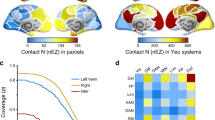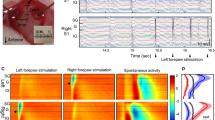Abstract
Cross-correlation analysis was used to observe interhemisphere synchronization of motor cortex neuron activity in anesthetized rats, which was seen on cross-correlograms as peaks located symmetrically relative to the coordinate origin. Peaks included “narrow” peaks (less than 20 msec) and “intermediate” peaks (30–80 msec). The results showed that the “common” source synchronizing the discharges of pairs of neurons located in different hemispheres of the brain might be a neuron (or group of neurons) located in one of the hemispheres and playing this role when there were reciprocal excitatory connections between it and each neuron in a pair. Comparison of the widths of symmetrical peaks with latent periods corresponding to transcallosal connections suggested that mono- and polysynaptic connections underlie the formation of “narrow” and “intermediate” peaks respectively.
Similar content being viewed by others
References
O. G. Bogdanova, “Features of background gamma oscillations in neuronal networks including callosal cells,”Zh. Vyssh. Nerv. Deyat.,47, No. 4, 771–776 (1997).
I. G. Sil'kis, “Excitatory interactions in neuronal networks including cells of the auditory cortex and medial geniculate body,”Zh. Vyssh. Nerv. Deyat.,44, No. 4–5, 762–777 (1994).
I. G. Sil'kis, “Inhibitory interactions in neuronal networks including cells of the auditory cortex and medial geniculate body,”Zh. Vyssh. Nerv. Deyat.,44, No. 6, 1046–1059 (1994).
I. G. Sil'kis, “Long-term changes in the efficiency of excitatory and inhibitory connections in neuronal micronetworks of the motor cortex evoked by tetanization of the thalamic nuclei and the sensory cortex,”Zh. Vyssh. Nerv. Deyat.,45, No. 5, 932–948 (1995).
V. M. Storozhuk,Functional Organization of Somatic Cortex Neurons [in Russian], Naukova Dumka, Kiev (1974).
Y. Chagnac-Amitai and B. W. Connors, “Horizontal spread of synchronized activity in neocortex and its control by GABA-mediated inhibition,”J. Neurophysiol.,61, 747–758 (1989).
J. J. Eggermont, G. M. Smith, and D. Bowman, “Spontaneous burst firing in cat primary auditory cortex: age and depth dependence and its effect on neural interaction measures,”J. Neurophysiol.,69, 1292–1313 (1993).
A. K. Engel, P. Konig, A. K. Kreiter, and W. Singer, “Interhemispheric synchronization of oscillatory neuronal responses in cat visual cortex,”Science,252, 1177–1179 (1991).
G. L. Gerstein and D. H. Perkel, “Mutual temporal relationships among neuron spike trains,”Biophys. J.,12, 453–473. (1972).
P. Konig and A. K. Engel, “Correlated firing in sensory-motor systems,”Curt. Opinion in Neurobiol.,5, 511–519 (1995).
L. C. Nowak, M. H. J. Munk, J. I. Nelson, A. C. James, and J. Buller, “The structural bases of cortical synchronization. I. Three types of interhemispheric coupling,”J. Neurophysiol.,74, 2379–2400 (1995).
A. Mason, A. Nicoll, and K. J. Stratford, “Synaptic transmission between individual pyramidal neurons of the rat visual cortex in vitro,”J. Neurosci.,11, 72–84 (1991).
M. Matsumara, D.-F. Chen, T. Sawaguchi, K. Kubota, and E. E. Fetz, “Synaptic interactions between primate precentral cortex neurons revealed by spike-triggering averaging of intracellular membrane potentials in vivo,”J. Neurosci.,16, 7757–7767 (1996).
M. H. J. Munk, L. G. Nowak, J. I. Nelson, and J. Buller, “The structural bases of cortical synchronization. II. Effects of cortical lesions,”J. Neurophysiol.,74, 2401–2414 (1995).
D. H. Perkel, G. L. Gerstein, and G. P. Moore, “Neuronal spike trains and stochastic point processes. II. Simultaneous spike trains,”Biophys. J.,7, 419–441 (1967).
A. M. Thomson and J. Deuchars, “Temporal and spatial properties of local circuits in neocortex,”Trends Neurosci.,17, 119–126 (1994).
K. Toyama, M. Kimura, and K. Tanaka, “Cross-correlation analysis of interneuronal connectivity in cat visual cortex,”J. neurophysiol.,46, 191–201 (1981).
E. Vaadia, E. Ahissar, H. Bergman, and Y. Lavner, “Correlated activity of neurons. A neural code for higher brain function?,” in:Neural Cooperativity, Berlin, Heidelberg (1991).
Author information
Authors and Affiliations
Additional information
Translated from Rossiiskii Fiziologicheskii Zhurnal imeni I. M. Sechenova, Vol. 84, No. 7, pp. 624–633, July, 1998.
Rights and permissions
About this article
Cite this article
Sil'kis, I.G., Bogdanova, O.G. The properties and possible mechanisms of interhemisphere synchronization in the motor cortex of the rat. Neurosci Behav Physiol 29, 523–530 (1999). https://doi.org/10.1007/BF02461144
Received:
Revised:
Issue Date:
DOI: https://doi.org/10.1007/BF02461144




